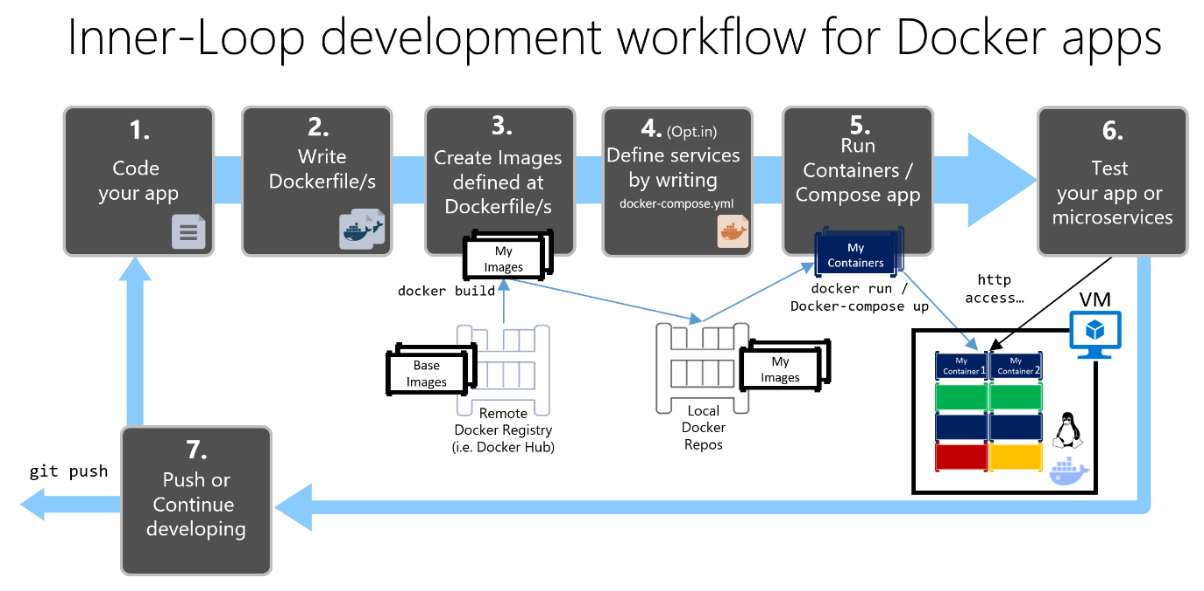Update containers If you make a configuration change to a service and run docker-compose up to update it, the old container is removed and the new one joins the network under a different IP address but the same name. Make COMPOSEDOCKERCLIBUILD=1 the default. Add usage metrics. Sync schema with COMPOSE specification. Improve failure report for missing mandatory environment variables. Bump attrs to 20.3.0. Bump moreitertools to 8.6.0. Bump cryptograhy to 3.2.1. Bump cffi to 1.14.4. Bump virtualenv to 20.2.2. Bump bcrypt to 3.2.0. Bump gitpython to 3.1.11. When you run docker-compose up -d command the first time with the above yml definition, it will create a volume, not with a random string as its name, but db-bata as its name. Then onwards every time you bring the application down (docker-compose down) and then rerun the docker-compose up -d compose will try to create a volume named db-data but. Update containers If you make a configuration change to a service and run docker-compose up to update it, the old container is removed and the new one joins the network under a different IP address but the same name. Use Docker Compose. Docker Compose provides a way to orchestrate multiple containers that work together. Examples include a service that processes requests and a front-end web site, or a service that uses a supporting function such as a Redis cache.
Estimated reading time: 6 minutes
This page applies to Compose file formats version 2 and higher. Networking features are not supported for Compose file version 1 (deprecated).
By default Compose sets up a singlenetwork for your app. Eachcontainer for a service joins the default network and is both reachable byother containers on that network, and discoverable by them at a hostnameidentical to the container name.
Note
Your app’s network is given a name based on the “project name”,which is based on the name of the directory it lives in. You can override theproject name with either the --project-name flagor the COMPOSE_PROJECT_NAME environment variable.
For example, suppose your app is in a directory called myapp, and your docker-compose.yml looks like this:
When you run docker-compose up, the following happens:
- A network called
myapp_defaultis created. - A container is created using
web’s configuration. It joins the networkmyapp_defaultunder the nameweb. - A container is created using
db’s configuration. It joins the networkmyapp_defaultunder the namedb.
In v2.1+, overlay networks are always attachable
Starting in Compose file format 2.1, overlay networks are always created asattachable, and this is not configurable. This means that standalonecontainers can connect to overlay networks.
In Compose file format 3.x, you can optionally set the attachable propertyto false.
Each container can now look up the hostname web or db andget back the appropriate container’s IP address. For example, web’sapplication code could connect to the URL postgres://db:5432 and startusing the Postgres database.
It is important to note the distinction between HOST_PORT and CONTAINER_PORT.In the above example, for db, the HOST_PORT is 8001 and the container port is5432 (postgres default). Networked service-to-servicecommunication uses the CONTAINER_PORT. When HOST_PORT is defined,the service is accessible outside the swarm as well.
Within the web container, your connection string to db would look likepostgres://db:5432, and from the host machine, the connection string wouldlook like postgres://{DOCKER_IP}:8001.
Update containers
If you make a configuration change to a service and run docker-compose up to update it, the old container is removed and the new one joins the network under a different IP address but the same name. Running containers can look up that name and connect to the new address, but the old address stops working.

If any containers have connections open to the old container, they are closed. It is a container’s responsibility to detect this condition, look up the name again and reconnect.
Links
Links allow you to define extra aliases by which a service is reachable from another service. They are not required to enable services to communicate - by default, any service can reach any other service at that service’s name. In the following example, db is reachable from web at the hostnames db and database:
See the links reference for more information.
Multi-host networking
When deploying a Compose application on an Docker Engine with Swarm mode enabled,you can make use of the built-in overlay driver to enable multi-host communication.
Consult the Swarm mode section, to see how to set upa Swarm cluster, and the Getting started with multi-host networkingto learn about multi-host overlay networks.
Specify custom networks
Instead of just using the default app network, you can specify your own networks with the top-level networks key. This lets you create more complex topologies and specify custom network drivers and options. You can also use it to connect services to externally-created networks which aren’t managed by Compose.
Each service can specify what networks to connect to with the service-levelnetworks key, which is a list of names referencing entries under the top-levelnetworks key.
Docker Compose Update One Container
Here’s an example Compose file defining two custom networks. The proxy service is isolated from the db service, because they do not share a network in common - only app can talk to both.
Networks can be configured with static IP addresses by setting the ipv4_address and/or ipv6_address for each attached network.
Networks can also be given a custom name (since version 3.5):

Docker Compose Update Service
For full details of the network configuration options available, see the following references:
Configure the default network
Docker Compose Update Image
Instead of (or as well as) specifying your own networks, you can also change the settings of the app-wide default network by defining an entry under networks named default:
Use a pre-existing network
If you want your containers to join a pre-existing network, use the external option:
Instead of attempting to create a network called [projectname]_default, Compose looks for a network called my-pre-existing-network and connect your app’s containers to it.
